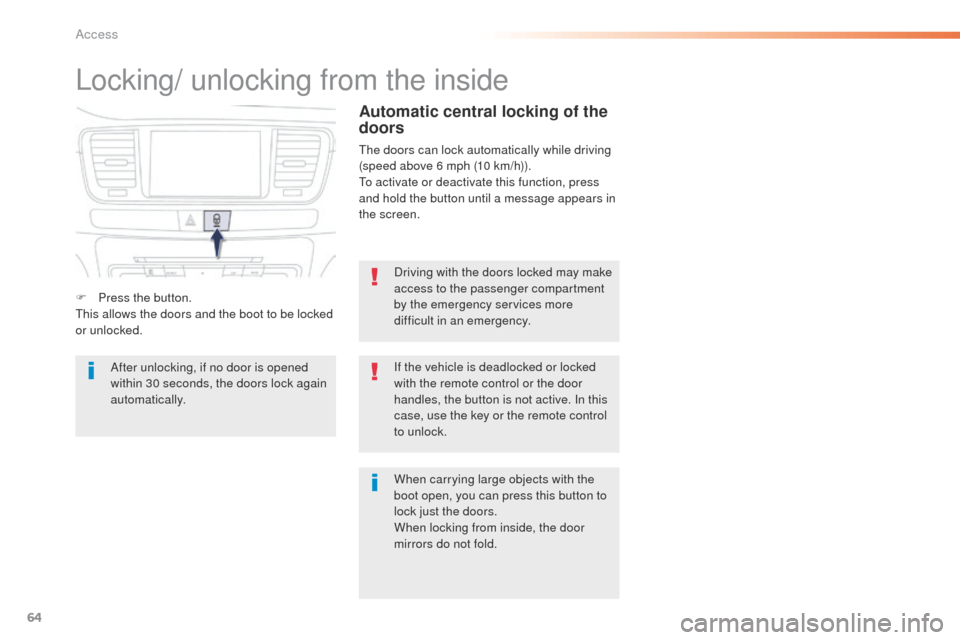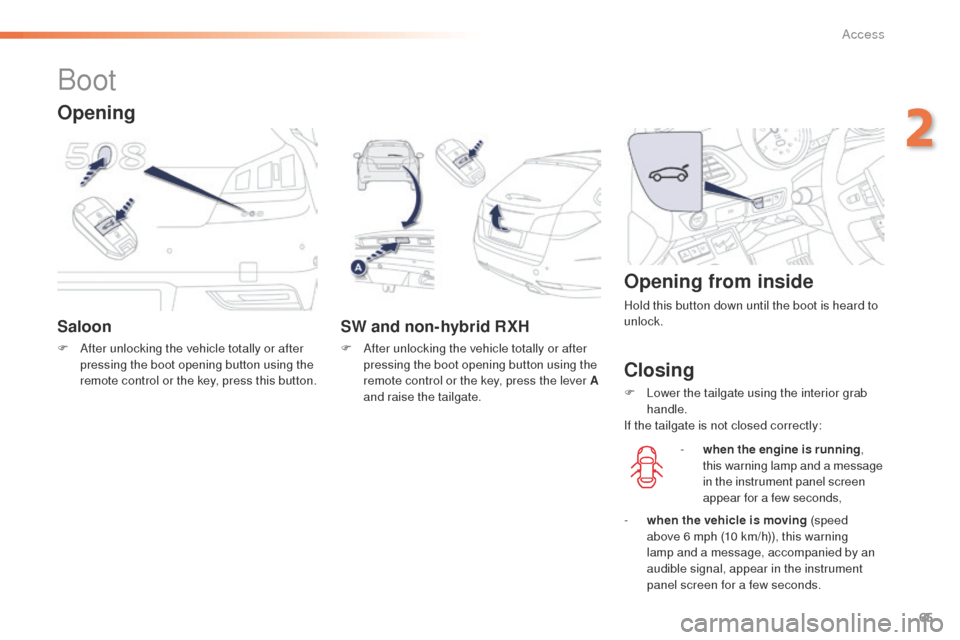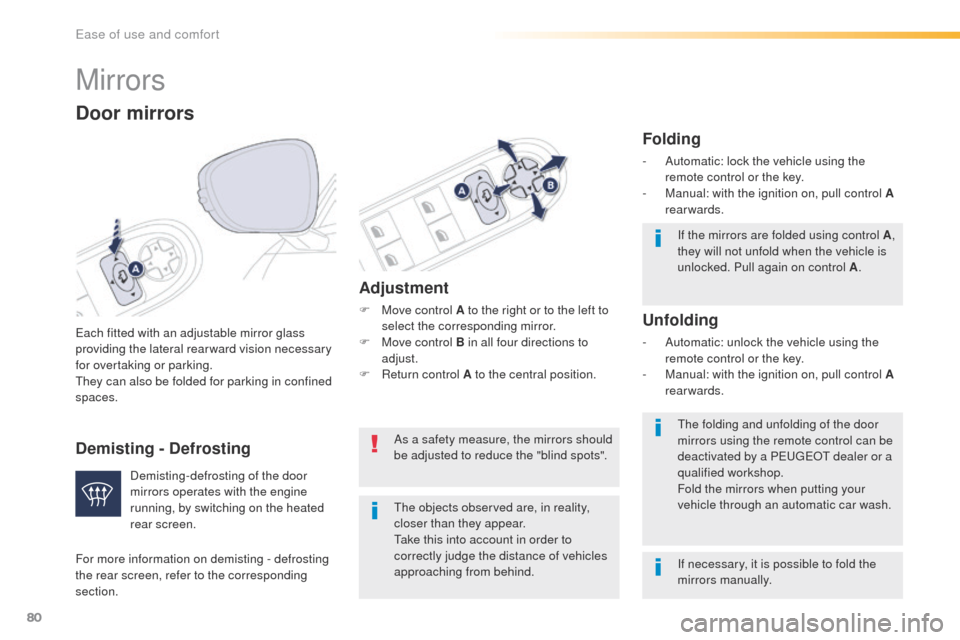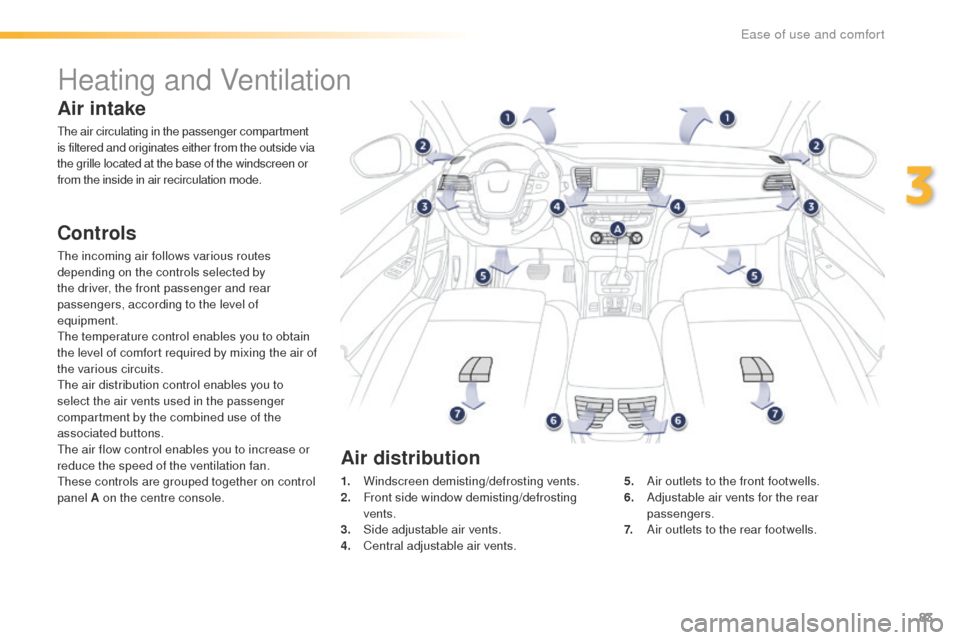2016 Peugeot 508 RXH scr
[x] Cancel search: scrPage 65 of 364

63
508_en_Chap02_ouvertures_ed01-2016
Do not throw the remote control
batteries away, they contain metals
which are harmful to the environment.
ta
ke them to an approved collection
point.
Changing the battery of the
electronic key
Battery ref.: CR2032 / 3 volts.th is replacement battery is available from a
P
e
uge
Ot
dealer or a qualified workshop.
A message is displayed in the instrument panel
screen when replacement of the battery is
needed.
F
u
n
clip the cover using a pointed object at
the key ring.
F
S
lide the flat battery out of its location.
F
S
lide the new battery into its location
observing the original direction of fitment.
F
C
lip the cover in place starting at the front.
F
R
einitialise the electronic key.
Electronic key fault
Following disconnection of the vehicle battery,
replacement of the remote control battery or
in the event of a fault with the remote control,
you can no longer unlock, lock or locate your
vehicle.
F
F
irst of all, use the key in the door lock to
unlock or lock your vehicle.
F
t
hen
, reinitialise the remote control.
If the problem persists, contact a P
e
uge
Ot
dealer or a qualified workshop as soon as
possible.
Reinitialisation
F Switch the ignition off.
F I mmediately press one of the remote
control buttons for a few seconds.
F
S
witch the ignition on.
th
e electronic key is fully operational again.
2
Access
Page 66 of 364

64
508_en_Chap02_ouvertures_ed01-2016
Locking/ unlocking from the inside
Driving with the doors locked may make
access to the passenger compartment
by the emergency services more
difficult in an emergency.
If the vehicle is deadlocked or locked
with the remote control or the door
handles, the button is not active. In this
case, use the key or the remote control
to unlock.
F
P
ress the button.
th
is allows the doors and the boot to be locked
or unlocked.
When carrying large objects with the
boot open, you can press this button to
lock just the doors.
When locking from inside, the door
mirrors do not fold.
Automatic central locking of the
doors
the doors can lock automatically while driving
(speed above 6 mph (10 km/h)).
to a
ctivate or deactivate this function, press
and hold the button until a message appears in
the screen.
After unlocking, if no door is opened
within 30 seconds, the doors lock again
automatically.
Access
Page 67 of 364

65
508_en_Chap02_ouvertures_ed01-2016
Boot
Saloon
F After unlocking the vehicle totally or after pressing the boot opening button using the
remote control or the key, press this button.
SW and non-hybrid RXH
F After unlocking the vehicle totally or after pressing the boot opening button using the
remote control or the key, press the lever A
and raise the tailgate.
Opening from inside
Opening
Hold this button down until the boot is heard to
unlock.
-
w
hen the engine is running ,
this warning lamp and a message
in the instrument panel screen
appear for a few seconds,
-
w
hen the vehicle is moving (speed
above
6 mph (10 km/h)), this warning
lamp and a message, accompanied by an
audible signal, appear in the instrument
panel screen for a few seconds.
Closing
F Lower the tailgate using the interior grab handle.
If the tailgate is not closed correctly:
2
Access
Page 70 of 364

68
508_en_Chap02_ouvertures_ed01-2016
Back-up release (Saloon,
SW and non-hybrid RHX)
System for mechanically unlocking the boot in
the event of a battery or central locking fault.
Unlocking
F Fold the rear seats to gain access to the lock from inside the boot.
F
I
nsert a small screwdriver into hole A of
the lock, then move the lever to the left to
unlock the boot."Boot open" warning
With the engine running or when the vehicle is moving,
if the tailgate is not properly closed, a message
accompanied by an audible signal (from 6 mph
(10
km/h)) is displayed in the instrument panel screen.
Locking again after closing
Once closed again, the boot will remain locked
if the problem persists.
Adjusting the opening
height
the maximum opening height of the tailgate
can be set and memorised (restricted overhead
clearance, ...).
th
is memorisation is done in two steps, by
successive presses on button C :
-
d
uring opening, a first press stops the
tailgate at the desired height,
-
a s
econd maintained press memorises the
position of the tailgate; an audible signal
confirms the memorisation.
t
o d
elete this memorisation, make a new
maintained press until the audible signal is
heard.
th
e tailgate is not designed to support
a bicycle carrier.
If fitting a bicycle carrier to a towbar,
the automatic operation must be
deactivated. Precautions in use
If snow has accumulated on the
tailgate, remove the snow before any
automatic operation of the tailgate.
Ice can prevent opening of the tailgate:
wait until the ice has melted following
heating of the passenger compartment.
When washing the vehicle in an
automatic car wash, don't forget to
lock your vehicle to prevent any risk of
unwanted opening.
Repeated opening and closing of the
tailgate can overheat the electric motor;
neither closing nor opening is then
possible.
Allow the motor to cool down for
ten
minutes before operating the
tailgate again.
Access
Page 82 of 364

80
508_en_Chap03_ergonomie-et-confort_ed01-2016
Mirrors
each fitted with an adjustable mirror glass
providing the lateral rear ward vision necessary
for overtaking or parking.
th
ey can also be folded for parking in confined
spaces.
Door mirrors
If the mirrors are folded using control A ,
they will not unfold when the vehicle is
unlocked. Pull again on control A .
th
e folding and unfolding of the door
mirrors using the remote control can be
deactivated by a P
e
uge
Ot
dealer or a
qualified workshop.
Fold the mirrors when putting your
vehicle through an automatic car wash.
th
e objects observed are, in reality,
closer than they appear.
ta
ke this into account in order to
correctly judge the distance of vehicles
approaching from behind.
Demisting-defrosting of the door
mirrors operates with the engine
running, by switching on the heated
rear screen.
Adjustment
F Move control A to the right or to the left to
select the corresponding mirror.
F
M
ove control B in all four directions to
adjust.
F
R
eturn control A to the central position.
Folding
- Automatic: lock the vehicle using the remote control or the key.
-
M
anual: with the ignition on, pull control A
rearwards.
Unfolding
- Automatic: unlock the vehicle using the remote control or the key.
-
M
anual: with the ignition on, pull control A
rearwards.
As a safety measure, the mirrors should
be adjusted to reduce the "blind spots".
If necessary, it is possible to fold the
mirrors manually.
For more information on demisting - defrosting
the rear screen, refer to the corresponding
section.
Demisting - Defrosting
ease of use and comfort
Page 85 of 364

83
508_en_Chap03_ergonomie-et-confort_ed01-2016
Heating and Ventilation
Air intake
the air circulating in the passenger compartment
is filtered and originates either from the outside via
the grille located at the base of the windscreen or
from the inside in air recirculation mode.
Controls
the incoming air follows various routes
depending on the controls selected by
the driver, the front passenger and rear
passengers, according to the level of
equipment.
th
e temperature control enables you to obtain
the level of comfort required by mixing the air of
the various circuits.
th
e air distribution control enables you to
select the air vents used in the passenger
compartment by the combined use of the
associated buttons.
th
e air flow control enables you to increase or
reduce the speed of the ventilation fan.
th
ese controls are grouped together on control
panel A on the centre console. 1.
W
indscreen demisting/defrosting vents.
2.
F
ront side window demisting/defrosting
vents.
3.
S
ide adjustable air vents.
4.
C
entral adjustable air vents.5.
A
ir outlets to the front footwells.
6.
A
djustable air vents for the rear
passengers.
7.
A
ir outlets to the rear footwells.
Air distribution
3
ease of use and comfort
Page 87 of 364

85
508_en_Chap03_ergonomie-et-confort_ed01-2016
Recommendations for ventilation and air conditioning
the air conditioning system does not contain chlorine and does not present any danger to the ozone layer. In order for these systems to be fully effective, follow the operation and maintenance guidelines below:
F
I
f the interior temperature remains very high after the vehicle has been parked in the sun for a considerable time, first ventilate the
passenger compartment for a few minutes.
P
lace the air flow control at a sufficient level to provide an adequate renewal of air in the passenger compartment.
F t
o o
btain an even air distribution, take care not to obstruct the exterior air intake grilles located at the base of the windscreen, the nozzles,
the vents and the air outlets, as well as the air extractor located in the boot.
F
I
n normal conditions, use the intake of exterior air as prolonged use of the air recirculation may cause misting of the windows and side
windows.
F
D
o not cover the sunshine sensor, located on the dashboard; this is used for regulation of the automatic air conditioning system.
F
O
perate the air conditioning system for 5 to 10 minutes, once or twice a month to keep it in good working order.
F e
n
sure that the passenger compartment filter is in good condition and have the filter elements replaced regularly (refer to the "Checks"
section).
W
e recommend the use of a combined passenger compartment filter. t
h
anks to its second special active filter, it contributes to the
purification of the air breathed by the occupants and the cleanliness of the passenger compartment (reduction of allergic symptoms, bad
odours and greasy deposits).
F t
h
e air conditioning uses power from the engine while operating. t
h
is results in an increase in the vehicle's fuel consumption.
W
hen towing at or near maximum capacity or on steep slopes in high ambient temperatures, switching off the air conditioning saves engine
power and so improves towing capacity.
C
ondensation created by the air conditioning results in a discharge of water under the vehicle when stationary, which is per fectly normal.
F t
o e
nsure correct operation of the air conditioning system, you are also advised to have it checked regularly.
F
I
f the system does not produce cold air, do not use it and contact a P
e
uge
Ot
dealer or a qualified workshop.
3
ease of use and comfort
Page 88 of 364

86
508_en_Chap03_ergonomie-et-confort_ed01-2016
Manual air conditioning
the air conditioning can only operate with the engine running.
1. Temperature adjustment
F turn the dial from left (cold) to right (hot) to adjust
the temperature to your
requirements.
2. Air flow adjustment
F Press the "full fan" button to
increase the air flow.
A
ccording to the value selected,
the associated line of L
eD
s fills
progressively.
F
P
ress the "empty fan"
button to
reduce the air flow.
3. Air distribution adjustment
F Press the corresponding button for:
Windscreen and side windows.
Central and side vents.
Footwells.
Depending on your requirements, you
can combine two distribution buttons
or select the three distribution modes
simultaneously.
ease of use and comfort